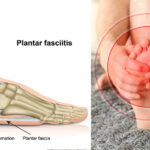Heel pain is the most common problem affecting the foot and ankle, according to the American Academy of Orthopaedic Surgeons. Every year, approximately 2 million people are diagnosed with plantar fasciatis, one of the most common causes for this type of foot pain. This condition occurs when the thick band of tissue (the plantar fascia) on the bottom of your foot connecting your heel bone to your toes, becomes irritated and inflamed.
In most cases, plantar fasciitis causes a deep, stabbing pain in the bottom of the foot, usually within the first few steps of the morning. Over the course of the day, the pain usually decreases, although it can be reignited after long periods of standing or to stand after sitting for a long period of time.
Most often, plantar fasciitis is a problem among runners, as well as people who are overweight or wear shoes with inadequate support, according to Mayo Clinic. However, many people can develop this condition without any obvious cause.
Some factors that could increase your risk of plantar fasciitis include:
Age
Plantar fasciitis is most common among 40 to 60 year-olds.
Certain types of exercise
Repetitive impact activities, including running, can place a lot of stress on the plantar fascia overtime. Moreover, increasing your exercise or trying out new workout routines can sometimes add extra stress to your feet, causing pain in the plantar fascia.
Foot mechanics
Flat feet, high arches, or even abnormal walking patterns can affect the way weight is distributed when you’re standing and place added stress on the muscle tendons in your feet.
Obesity
Excess body weight can put extra stress on your feet and legs.
Occupations that keep you on your feet
People that spend most of their work hours walking or standing on hard surfaces can damage the bottoms of their feet.
Signs & Symptoms
The most common symptoms of plantar fasciitis include:
- Pain on the bottom of the foot near the heel
- Pain in the first few steps after getting out of bed in the morning
- Pain in the first steps after a long period of rest, such as after a long car ride
- Increased pain after exercise or activity
Some ways to reduce the pain from plantar fasciitis include:
- Applying ice for 15 minutes, 3 to 4 times a day.
- Incorporating low-impact exercises in your fitness routine.
- Wearing shoes that supports the inner arch and sole of the foot.
- Wearing orthotic shoe inserts that help distribute pressure and provide arch support.
- Stretching out the plantar fascia and calf muscles.
To stretch out your plantar fascia:
Start by sitting in a chair with both feet flat against the ground. Cross the affected foot over the knee of your other leg. Grasp the toes of your painful foot and slowly pull them toward you in a controlled fashion. If it is difficult to reach your foot, wrap a towel around your big toe to help pull your toes toward you. Place your other hand along the plantar fascia. The fascia should feel like a tight band along the bottom of your foot when stretched. Hold the stretch for 10 seconds. Repeat it 20 times for each foot. This exercise is best done in the morning before standing or walking.
To stretch out your calf muscles:
Lean forward against a wall with one knee straightened and the heel on the ground. Place the other leg in front, with the knee bent. To stretch the calf muscles and the heel cord, push your hips toward the wall in a controlled fashion. Hold the position for 10 seconds and relax. Repeat this exercise 20 times for each foot. A strong pull in the calf should be felt during the stretch.
When to See a Doctor
If the pain in your heel does not subside after a few weeks, and continues to grow worse, consider seeing your doctor for professional treatment. Moreover, if you notice decreased mobility in your feet, toes, or legs; if you have a fever; if you experience numbness or tingling in your heel; if the pain continues when you’re sitting or lying down, schedule an appointment with your doctor.



